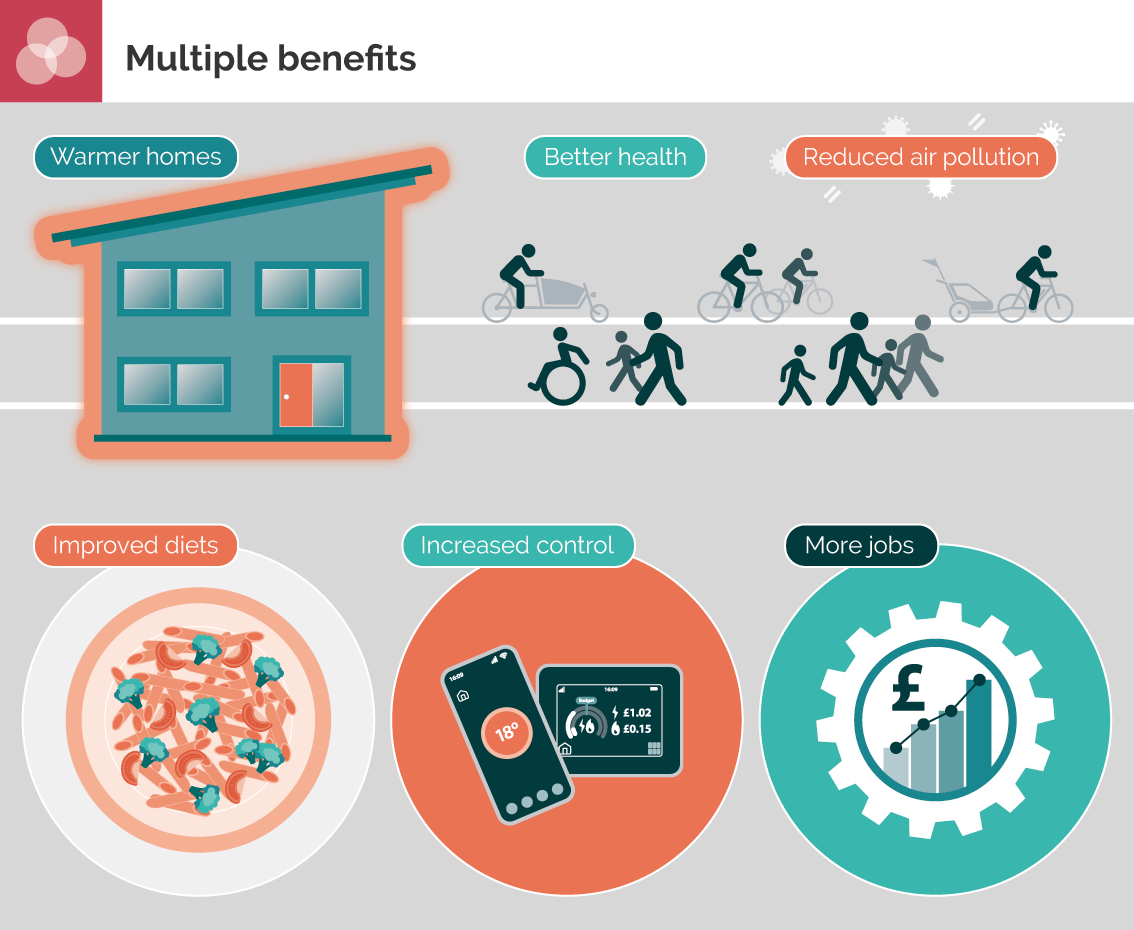
Lower energy demand invariably leads to operational cost and emission savings, which are frequently assumed to be the main benefits of reducing energy demand, and the primary drivers for it. However, demand-side actions also have wider benefits.
These ‘multiple benefits’ are diverse [1] and include health improvement due to warmer homes, improved air quality, more active lifestyles and better diets. Demand side investment also creates jobs and wealth. And demand reduction and flexibility increase energy system security. In many cases, these benefits can be the key drivers for change.
Transport related emissions are a major cause of air pollution. Tackling the climate and air pollution crises requires curbing motorised transport, particularly private cars, as quickly as possible [2]. Making travel affordable, reliable, clean and healthy and reducing congestion are stronger drivers for local action than energy demand reduction [3]. Active travel [4] and lower meat diets [5] also have major health benefits.
In buildings, energy efficiency can result in considerable health benefits. Many UK homes are too cold, particularly for vulnerable people [6]. Older dwellings, detached homes, single occupancy and northern locations are key risk factors [7, 8]. However, attention to ventilation is also needed to avoid unintended health consequences, including from radon [9] and elevated carbon dioxide [10], and to the increased risks of overheating as the climate warms [11]. And poorly designed or implemented fabric insulation can have disastrous consequences.
Demand side investment tends to generate economic activity that has a high propensity to create jobs locally and within the UK [12]. Building retrofit makes a larger contribution than new build to GDP, income and jobs [13]. Energy efficiency programmes in buildings and industry can therefore support post-pandemic recovery [14]. If well-designed, these can support skills and retraining for a net-zero economy, e.g. by re-training gas installers [15].
Digitalisation will continue to make a major contribution to increasing economic growth as well as the potential to improve energy efficiency significantly [16]. However, it also has potential dis-benefits, for example the security implications of smart devices [17] and generation of e-waste [18], which must be anticipated and managed.
Some of the benefits of demand side change relate to reducing non-energy emissions. For example, a major benefit from changing diets is a reduction in land-use emissions (of both carbon dioxide and methane) [5].
Evidence
- Much broader than health: Surveying the diverse co-benefits of energy demand reduction in Europe | Research paper, 2022
- Energy, pollution and climate change | Research paper, 2021
- Active travel’s contribution to climate change mitigation: Research summary and outlook | Research paper, 2021
- Cycling, climate change and air pollution | Research paper, 2022
- Towards net-zero nutrition: the contribution of demand-side change to mitigating UK food emissions | Research paper, 2021
- Associations between indoor temperature, self-rated health and socioeconomic position in a cross-sectional study of adults in England | Research paper, 2021
- Comparison of indoor temperatures of homes with recommended temperatures and effects of disability and age: an observational, cross-sectional study | Research paper, 2018
- Observational evidence of the seasonal and demographic variation in experienced temperature from 77,743 UK Biobank participants | Research paper, 2019
- Home energy efficiency and radon: An observational study | Research paper, 2019
- Possible future impacts of elevated levels of atmospheric CO2 on human cognitive performance and on the design and operation of ventilation systems in buildings | Research paper, 2018
- Population-weighted degree-days: The global shift between heating and cooling | Research paper, 2022
- Socio-macroeconomic impacts of implementing different post-Brexit UK energy reduction targets to 2030 | Research paper, 2021
- Socio-macroeconomic impacts of meeting new build and retrofit UK building energy targets to 2030: a MARCO-UK modelling study | Research paper, 2020
- Macro-economic impacts of green policies in the Economic Recovery Package post-Covid | CREDS report, 2021
- A reform agenda for UK construction education and practice | Research paper, 2020
- Twin transitions of decarbonisation and digitalisation: A historical perspective on energy and information in European economies | Research paper, 2022
- Critically reviewing smart home technology applications and business models in Europe | Research paper, 2020
- The energy use implications of 5G: Reviewing whole network operational energy, embodied energy, and indirect effects | Research paper, 2022
Banner photo credit: Pat Whelen on Unsplash
